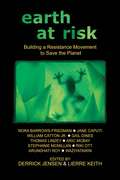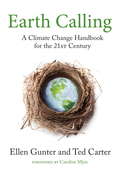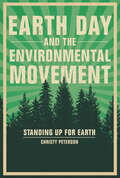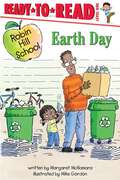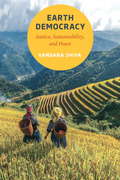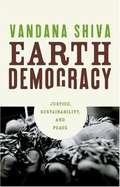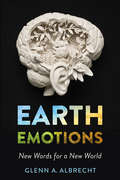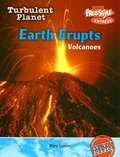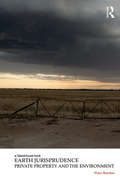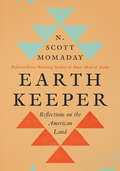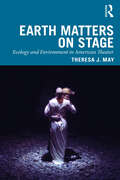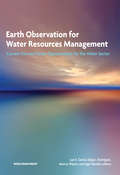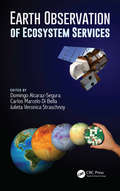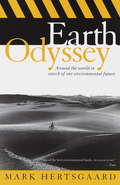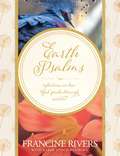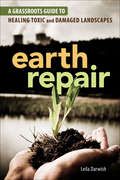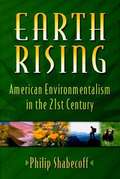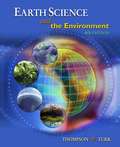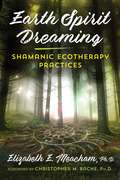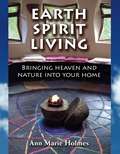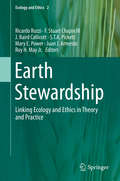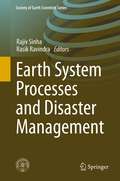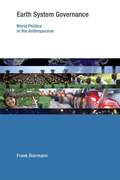- Table View
- List View
Earth At Risk: Building A Resistance Movement To Save The Planet
by Derrick Jensen Lierre KeithThe annual conference Earth at Risk: Building a Resistance Movement to Save the Planet features environmental thinkers and activists who are willing to ask the hardest questions about the seriousness of the planet's situation, and this book presents an impassioned critique of the dominant culture from every angle. Speakers from the conference are featured in this volume and include William Catton, who explains ecological overshoot; Thomas Linzey, who gives a fiery call for community sovereignty; Jane Caputi, who exposes patriarchy's mythic dismemberment of the goddess; Aric McBay, who discusses historically effective resistance strategies; and Stephanie McMillan, who takes down capitalism. One by one, they build an unassailable case that the rich should be deprived of their ability to steal from the poor and the powerful of their ability to destroy the planet. These speakers offer their ideas on what can be done to build a real resistance movement: one that includes all levels of direct action that can actually match the scale of the problem. Also included are the speakers Derrick Jensen, Arundhati Roy, Rikki Ott, Gail Dines, Waziyatawin, Lierre Keith, and Nora Barrows-Friedman.
Earth Calling
by Caroline Myss Ted Carter Ellen GunterOur earliest mythologies tell us we all start as a little bit of dirt. These stories carry a profound message: each of us is born with a deep and abiding connection to the earth, one that many of us have lost touch with. The Silent Spring for today's environmental activists, this book offers an invitation to reestablish our relationship with nature to repair our damaged environment. Chapter 1 examines the threats to the planet's health through the lens of the human energy system known as the chakras, describing how the broken first chakra relates to our disconnection from our biosphere. Chapter 2 shows how our current environmental crises--global warming, climate change, dwindling water resources, natural disasters such as wildfires and hurricanes--represent severe manifestations of our disconnection from the earth.Chapter 3 describes how the preponderance of oil in our culture--especially agribusiness--compounds this disconnection, from our dependence on other countries for our energy, to current issues of oil depletion, peak oil, and fracking, to the dumbing down of our agricultural polyculture.Chapter 4 explains how the most basic building blocks of our nourishment--seeds--are being compromised with a loss of biodiversity and rise of GMOs, and how that adversely affects the farmers whose sacred connection to the land has in many cases been severed. Chapter 5 describes the ways in which we as individuals can begin to wake up to climate activism as a spiritual practice. This chapter includes specific activities that you can use to implement change and heal your own connection to the earth. By learning and practicing ritual and understanding the earth's rhythms and seasonal rites of passage, each of us can find unique ways to heal our own connections and help others heal theirs. Chapter 6 brings to life Goethe's wisdom: "Knowing isn't enough; neither is being willing. We must do," by providing strategies and resources for exploring how each of us can find our own Earth Calling, then anchoring that calling with the only force that ignites change: Action.From the Trade Paperback edition.
Earth Day and the Environmental Movement: Standing Up for Earth
by Christy PetersonOn April 22, 1970, an estimated twenty million people held in a teach-in to show their support for environmental protections. This new celebration, Earth Day, brought together previously fragmented issues under the same banner. It was the largest nationwide event ever, and lawmakers took notice. But one day didn't change everything. Fifty years after the first Earth Day, climate change remains a dire concern. The divide between political parties continues to widen, and environmental policy has become an increasingly partisan issue. The spread of disinformation has also made climate change a debatable idea, rather than scientific fact. A new generation of advocates continue the fight to make environmental policy a top priority for the United States and for nations around the globe. "Our goal is an environment of decency, quality, and mutual respect for all human beings and all other living creatures . . . Our goal is a decent environment in its broadest, deepest sense."—Gaylord Nelson, Earth Day founder "[T]he potential consequences are certainly major in their impact on mankind. Now is the time. The research is clear. It is up to us now to summon the political will."—Robert Walker, US Representative from Pennsylvania "There's always a perception that business and industry and conservation groups . . . don't agree on anything. . . . [W]e can come together to demonstrate that we might be looking at it from different sides, but the outcome is the same."—Doug Miell, consultant, Georgia Chamber of Commerce
Earth Day: Ready-to-Read Level 1 (Robin Hill School)
by Margaret McNamaraIn the latest beginning reader from the bestselling, classroom based Robin Hill School series the class celebrates Earth Day! <p><p> The kids in Mrs. Connor's class are celebrating Earth Day, and everyone has lots of ideas on how to save the Earth...except Emma. Emma is worried that her ideas are not good enough. With the help of her dad and Mrs. Connor, Emma learns that her small ideas can have big results!
Earth Democracy
by Vandana ShivaWorld-renowned environmental activist and physicist Vandana Shiva calls for a radical shift in the values that govern democracies, condemning the role that unrestricted capitalism has played in the destruction of environments and livelihoods. She explores the issues she helped bring to international attention--genetic food engineering, culture theft, and natural resource privatization--uncovering their links to the rising tide of fundamentalism, violence against women, and planetary death. Struggles on the streets of Seattle and Cancun and in homes and farms across the world have yielded a set of principles based on inclusion, nonviolence, reclaiming the commons, and freely sharing the earth's resources. These ideals, which Dr. Shiva calls "Earth Democracy," serve as an urgent call to peace and as the basis for a just and sustainable future.From the Trade Paperback edition.
Earth Democracy: Justice, Sustainability, and Peace
by Vandana ShivaBoldly confronting the neoconservative Project for the New American Century, world-renowned physicist and activist Vandana Shiva responds withEarth Democracy, or, as she prophetically names it, "The People's Project for a New Planetary Millennium. " A leading voice in the struggle for global justice and sustainability, here Shiva describes what earth democracy could look like, outlining the bedrock principles for building living economies, living cultures and living democracies. Starting from the initial enclosure of the commons--the privatization of six million acres of public land in eighteenth-century Britain--Shiva goes on to reveal how the commons continue to shrink as more and more natural resources are patented and fenced. Accompanying this displacement from formerly accessible territory, she argues, is a growing attitude of disposability that erodes our natural resources, ecological sustainability and cultural diversity. Worse, human beings are by no means safe from this assignment of disposability. Through the forces of neoliberal globalization, economic and social exclusion work in deadly synergy to perpetrate violence on vulnerable groups, extinguishing the lives of millions. Yet these brutal extinctions are not the only trend shaping human history. Forthright and energetic, Vandana Shiva updates readers on the movements, issues and struggles she helped bring to international attention--the genetic engineering of food, the theft of culture and the privatization of natural resources--and deftly analyzes the successes and new challenges the global resistance now faces. From struggles on the streets of Seattle and Cancun and in homes and farms across the world has grown a set of principles based on inclusion, nonviolence, reclaiming the commons and freely sharing the earth's resources. These ideals, which Shiva calls "earth democracy," will serve as unifying points in our current movements, an urgent call to peace and the basis for a just and sustainable future.
Earth Education: A New Beginning
by Steve Van MatreEarth education aims to accomplish what environmental education set out to do, but didn't: to help people improve upon their cognitive and affective relationship with the earth's natural communities and life support systems, and begin crafting lifestyles that will lessen their impact upon those places and processes on behalf of all the earth's passengers. If you care about the health of our troubled planet, then you should read what this internationally known educator has to say about how we lost a whole generation of teachers and leaders and what you can do to help them find their way again.
Earth Emotions: New Words for a New World
by Glenn A. AlbrechtAs climate change and development pressures overwhelm the environment, our emotional relationships with Earth are also in crisis. Pessimism and distress are overwhelming people the world over. In this maelstrom of emotion, solastalgia, the homesickness you have when you are still at home, has become, writes Glenn A. Albrecht, one of the defining emotions of the twenty-first century.Earth Emotions examines our positive and negative Earth emotions. It explains the author's concept of solastalgia and other well-known eco-emotions such as biophilia and topophilia. Albrecht introduces us to the many new words needed to describe the full range of our emotional responses to the emergent state of the world. We need this creation of a hopeful vocabulary of positive emotions, argues Albrecht, so that we can extract ourselves out of environmental desolation and reignite our millennia-old biophilia—love of life—for our home planet. To do so, he proposes a dramatic change from the current human-dominated Anthropocene era to one that will be founded, materially, ethically, politically, and spiritually on the revolution in thinking being delivered by contemporary symbiotic science. Albrecht names this period the Symbiocene.With the current and coming generations, "Generation Symbiocene," Albrecht sees reason for optimism. The battle between the forces of destruction and the forces of creation will be won by Generation Symbiocene, and Earth Emotions presents an ethical and emotional odyssey for that victory.
Earth Erupts: Volcanoes (Turbulent Planet)
by Mary ColsonThis book explains what happens when a volcano violently explodes. Find out why volcanoes form and how to survive when the Earth Erupts.
Earth Hour: A Lights-Out Event for Our Planet
by Nanette HeffernanClick flashlights, light lanterns, and get ready to turn electric lights out to celebrate Earth Hour! Wherever you are, you can help our planet.Kids around the world use electric energy to do all kinds of things--adults do, too! From cleaning the clothes we play in, to lighting up our dinner tables, to keeping us warm and toasty when the weather is cold, electricity is a huge part of our lives. Unfortunately, it can also have a big impact on our planet.Earth Hour--a worldwide movement in support of energy conservation and sustainability--takes place each March and is sponsored by the World Wildlife Fund for Nature (WWF). During Earth Hour, individuals, communities, and businesses in more than 7,000 cities turn off nonessential electric lights for one hour. Across each continent--from the Eiffel Tower to the Great Wall of China to the Statue of Liberty--one small act reminds all of us of our enormous impact on planet Earth.
Earth Jurisprudence: Private Property and the Environment (Law, Justice and Ecology)
by Peter D. BurdonThe idea of human dominion over nature has become entrenched by the dominant rights-based interpretation of private property. Accordingly, nature is not attributed any inherent value and becomes merely the matter of a human property relationship. Earth Jurisprudence: Private Property and the Environment explores how an alternative conception of property might be instead grounded in the ecocentric concept of an Earth community. Recognising that human beings are deeply interconnected with and dependent on nature, this concept is proposed as a standard and measure for human law. This book argues that the anthropocentric institution of private property needs to be reconceived; drawing on international case law, indigenous views of property and the land use practices of agrarian communities, Peter Burdon considers how private property can be reformulated in a way that fosters duties towards nature. Using the theory of earth jurisprudence as a guide, he outlines an alternative ecocentric description of private property as a relationship between and among members of the Earth community. This book will appeal to those researching in law, justice and ecology, as well as anyone pursuing an interest more particularly in earth jurisprudence.
Earth Keeper: Reflections on the American Land (Native Keepers)
by N. Scott MomadayA beautifully written and poignant tribute to the Earth, from Pulitzer Prize-winning novelist and poet N. Scott Momaday. <p><p> One of the most distinguished voices in American letters, N. Scott Momaday has devoted much of his life to celebrating and preserving Native American culture, especially its oral tradition. A member of the Kiowa tribe who was born and grew up on Indian reservations throughout the Southwest, Momaday has an intimate connection to the land he knows well and loves deeply. <p> In Earth Keeper: Reflections on the American Land, he reflects on his native ground and its influence on his people. “When I think about my life and the lives of my ancestors, I am inevitably led to the conviction that I, and they, belong to the American land. This is a declaration of belonging. And it is an offering to the earth.” he writes. <p> Momaday recalls stories of his childhood, stories that have been passed down through generations, stories that reveal a profound and sacred connection to the American landscape and a reverence for the natural world. <p> In this moving and lyrical work, he offers an homage and a warning. Momaday reminds us that the Earth is a sacred place of wonder and beauty; a source of strength and healing that must be protected before it’s too late. As he so eloquently yet simply expresses, we must all be keepers of the Earth.
Earth Matters on Stage: Ecology and Environment in American Theater (Routledge Studies in Theatre, Ecology, and Performance)
by Theresa J. MayEarth Matters on Stage: Ecology and Environment in American Theater tells the story of how American theater has shaped popular understandings of the environment throughout the twentieth century as it argues for theater’s potential power in the age of climate change. Using cultural and environmental history, seven chapters interrogate key moments in American theater and American environmentalism over the course of the twentieth century in the United States. It focuses, in particular, on how drama has represented environmental injustice and how inequality has become part of the American environmental landscape. As the first book-length ecocritical study of American theater, Earth Matters examines both familiar dramas and lesser-known grassroots plays in an effort to show that theater can be a powerful force for social change from frontier drama of the late nineteenth century to the eco-theater movement. This book argues that theater has always and already been part of the history of environmental ideas and action in the United States. Earth Matters also maps the rise of an ecocritical thought and eco-theater practice – what the author calls ecodramaturgy – showing how theater has informed environmental perceptions and policies. Through key plays and productions, it identifies strategies for artists who want their work to contribute to cultural transformation in the face of climate change.
Earth Observation for Water Resources Management: Current Use and Future Opportunities for the Water Sector
by Luis Garcãa Pakulski Marcus Wijnen Diego RodrãguezWater systems are building blocks for poverty alleviation, shared growth, sustainable development, and green growth strategies. They require data from in-situ observation networks. Budgetary and other constraints have taken a toll on their operation and there are many regions in the world where the data are scarce or unreliable. Increasingly, remote sensing satellite-based earth observation is becoming an alternative. This book briefly describes some key global water challenges, perspectives for remote sensing approaches, and their importance for water resources-related activities. It describes eight key types of water resources management variables, a list of sensors that can produce such information, and a description of existing data products with examples. Earth Observation for Water Resources Management provides a series of practical guidelines that can be used by project leaders to decide whether remote sensing may be useful for the problem at hand and suitable data sources to consider if so. The book concludes with a review of the literature on reliability statistics of remote-sensed estimations.
Earth Observation of Ecosystem Services (Earth Observation of Global Changes)
by Domingo Alcaraz-Segura Carlos Marcelo Di Bella Julieta Veronica StraschnoyA balanced review of differing approaches based on remote sensing tools and methods to assess and monitor biodiversity, carbon and water cycles, and the energy balance of terrestrial ecosystem. Earth Observation of Ecosystem Services highlights the advantages Earth observation technologies offer for quantifying and monitoring multiple ecosystem fun
Earth Odyssey: Around the World in Search of Our Environmental Future
by Mark HertsgaardLike many of us, Mark Hertsgaard has long worried about the declining health of our environment. But in 1991, he decided to act on his own concern and investigate the escalating crisis for himself. Traveling on his own dime, he embarked on an odyssey lasting most of the decade and spanning nineteen countries. Now, inEarth Odysseyhe reports on our environmental predicament through the eyes of the people who live it. Earth Odysseyis a vivid, passionate narrative about one man's journey around the world in search of the answer to the essential question of our time: Is the future of the human species at risk? Combining first-rate reportage with irresistible storytelling, Mark Hertsgaard has written an essential--and ultimately hopeful--book about the uncertain fate of humankind.
Earth Psalms: Reflections On How God Speaks through Nature
by Francine Rivers Karin Stock BuursmaMillions of readers have been transformed and inspired by Francine Rivers' bestselling novels Redeeming Love and A Voice in the Wind. “From the depths of the sea to the far reaches of space ARE COUNTLESS BLESSINGS THE LORD OFFERS YOU. IN THIS WEEKLY DEVOTIONAL beloved author J. Francine Rivers invites you to join her in seeking the Creator through the marvelous natural world we live in. Francine shares observations she's gathered over a lifetime of exploring--abroad and in her own backyard--and reflects on how they might apply to your daily life. What do the majestic redwoods, the persistent woodpecker, or a glorious sunrise reveal about our artistic and generous God? How could that change your outlook or the way you handle adversity? Stunning photography, Scripture excerpts, applications, and prayers accompany Francine's reflections, inspiring you to be encouraged. Be challenged. Be comforted. God's power is immense; His attention to detail is precise; His love for you is vast and unfailing. The proof is all around you.”
Earth Repair: A Grassroots Guide to Healing Toxic and Damaged Landscapes
by Leila DarwishMillions of acres of land have been contaminated by pesticides, improperly handled chemicals, dirty energy projects, toxic waste, and other pollutants in the United States alone. This toxic legacy impacts the environment, our health, our watersheds, and land that could otherwise be used to grow healthy local food and medicines. Conventional clean-up techniques employed by government and industry are tremendously expensive and resource-intensive and can cause further damage. More and more communities find themselves increasingly unable to rely on those companies and governments who created the problems to step in and provide solutions.Earth Repair describes a host of powerful grassroots bioremediation techniques, including:Microbial remediation-using microorganisms to break down and bind contaminantsPhytoremediation-using plants to extract, bind, and transform toxinsMycoremediation-using fungi to clean up contaminated soil and waterPacked with valuable, firsthand information from visionaries in the field, Earth Repair empowers communities and individuals to take action and heal contaminated and damaged land. Encompassing everything from remediating and regenerating abandoned city lots for urban farmers and gardeners to recovering from environmental disasters and industrial catastrophes such as oil spills and nuclear fallout, this fertile toolbox is essential reading for anyone who wishes to transform environmental despair into constructive action.Leila Darwish is a community organizer, urban gardener, and permaculture designer with a focus on using grassroots bioremediation to address environmental justice issues in communities struggling with toxic contamination of their land and drinking water.
Earth Rising: American Environmentalism In The 21St Century
by Philip ShabecoffA general history of environmentalism in the United States.
Earth Science and the Environment (Fourth Edition)
by Graham R. Thompson Jon TurkUsing two themes, earth systems and environmental issues, EARTH SCIENCE AND THE ENVIRONMENT provides a rich overview of all Earth-related disciplines, including geology, meteorology, hydrology, oceanography, and astronomy. The authors provide a sense of how Earth functions as a single system composed of interacting subsystems and integrates coverage of enviromental issues in both the authoritative narrative and stunning multi-part visuals that emphasize the beauty of Earth science. To further enrich your experience, this earth science textbook is fully integrated with the CengageNOW online tutorial system. Web-based, assessment-driven, and completely flexible, the system provides you with a personalized learning plan based on a diagnostic pre-test to maximize your study time by focusing your attention where it is needed most.
Earth Spirit Dreaming: Shamanic Ecotherapy Practices
by Elizabeth E. MeachamA guide to co-creating a healing vision for humanity and the Earth through nature-connected shamanic rituals • Explains the Earth Spirit Dreaming process for rebirthing inherent shamanic abilities with dozens of practices in three categories: Earth-connecting practices, Spirit-connecting practices, and Dream-connecting practices • Provides experiential exercises to foster interactions with the intelligences and elemental energies of nature and the Spirit realm, realign you with the rhythms and flow of life, and co-create a healing dream for humanity and all of life on our planet • Contains step-by-step directions for connecting with the light guides of the planet for guidance and healing Humanity has become profoundly disconnected from the web of life on Earth as well as from nature as a whole. In this practical guide, Elizabeth E. Meacham details her field-tested method of shamanic ecotherapy practices to resolve this centuries-long trend toward disconnection. Through these practices, you will learn how to reconnect to Earth&’s systems and help restore health and balance to people and the planet. Translating transformative ideas from visionary environmental thinkers into engaging shamanic rituals for profound spiritual growth, Meacham offers dozens of practices in three categories: Earth-connecting practices, Spirit-connecting practices, and Dream-connecting practices. Building on one another, the exercises open channels to allow you to directly experience the intelligences of the Earth and Spirit realms, rebirth your inherent shamanic abilities, realign you with the rhythms and flow of life, and reclaim your ancestral power for co-creating a healing dream for our species and all of life on our planetary home. Guiding the reader through a progressively deepening journey toward connection with ourselves, each other, and the consciousness of our biosphere, the practices also invite profound mindfulness, as we work to hold a vision of connection with the Earth and Spirit realms, while choosing consciously to focus on joy, beauty, gratitude, love, and healing. Illuminating a shamanic awakening within Western culture at the dawn of an ecological age, Earth Spirit Dreaming reveals how the birth of a global consciousness of healing depends upon our commitment to individual and collective spiritual evolution. Calling us back to our shamanic heritage of a living nature spirituality, this manual offers much needed guidance on the essential journey back to an intimate love of Earth.
Earth Spirit Living
by Ann Marie HolmesEarth Spirit Living is a revolutionary approach to lifestyle design and personal space. Author Ann Marie Holmes, an expert on earth energy systems, reveals that by picking up subtle cues from the natural world, we can create healthy, enjoyable, and sustainable living spaces. She shows how we can effectively incorporate principles of sacred geometry, human intuition, and the power of space, shape, and layout to become aware of -- and collaborate with -- the earth's energies. Perfect for homeowners, renters, business owners, professional designers, and builders, Earth Spirit Living illuminates the benefits of living in cooperation with our environment, including: * a more comfortable home * increased effectiveness in your work * healthier, calmer living conditions * enhanced work and personal relationships * improved prosperity * smoother construction or remodeling process Insightful illustrations, ceremonies, cures, attunements, and visualizations will help you hone your natural instincts and strengthen your connection to your physical space. With client stories and personal anecdotes, Holmes guides you on the journey toward a balanced life and living space that harnesses the energy and wisdom of nature.
Earth Stewardship
by J. Baird Callicott F. Stuart Chapin III Ricardo Rozzi Juan J. Armesto S.T.A. Pickett Mary E. Power Roy H. May Jr.This book advances Earth Stewardship toward a planetary scale, presenting a range of ecological worldviews, practices, and institutions in different parts of the world and to use them as the basis for considering what we could learn from one another, and what we could do together. Today, inter-hemispheric, intercultural, and transdisciplinary collaborations for Earth Stewardship are an imperative. Chapters document pathways that are being forged by socio-ecological research networks, religious alliances, policy actions, environmental citizenship and participation, and new forms of conservation, based on both traditional and contemporary ecological knowledge and values. "The Earth Stewardship Initiative of the Ecological Society of America fosters practices to provide a stable basis for civilization in the future. Biocultural ethic emphasizes that we are co-inhabitants in the natural world; no matter how complex our inventions may become" (Peter Raven).
Earth System Processes and Disaster Management
by Rajiv Sinha Rasik RavindraOne of the fundamental goals of earth system science research is to adopt a more holistic view of the earth as a 'system' comprising different domains. The Society of Earth Scientists has brought out this multidisciplinary publication to emphasize the need of an integrated approach to understand the Earth system. It focuses on natural disasters and, in particular, on climate change and its effects in Asia and understanding the significance of these developments within the context of the paleo-climatic record. The later sections of the book then focus on other types of natural disasters as well as those induced by human interaction with our environment.
Earth System Governance
by Frank BiermannHumans are no longer spectators who need to adapt to their natural environment. Our impact on the earth has caused changes that are outside the range of natural variability and are equivalent to such major geological disruptions as ice ages. Some scientists argue that we have entered a new epoch in planetary history: the Anthropocene. In such an era of planet-wide transformation, we need a new model for planet-wide environmental politics. In this book, Frank Biermann proposes "earth system" governance as just such a new paradigm.Biermann offers both analytical and normative perspectives. He provides detailed analysis of global environmental politics in terms of five dimensions of effective governance: agency, particularly agency beyond that of state actors; architecture of governance, from local to global levels; accountability and legitimacy; equitable allocation of resources; and adaptiveness of governance systems. Biermann goes on to offer a wide range of policy proposals for future environmental governance and a revitalized United Nations, including the establishment of a World Environment Organization and a UN Sustainable Development Council, new mechanisms for strengthened representation of civil society and scientists in global decision making, innovative systems of qualified majority voting in multilateral negotiations, and novel institutions to protect those impacted by global change. Drawing on ten years of research, Biermann formulates earth system governance as an empirical reality and a political necessity.
